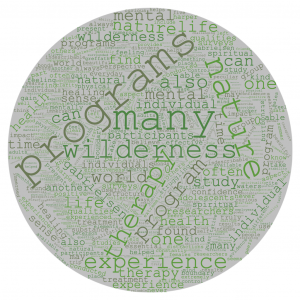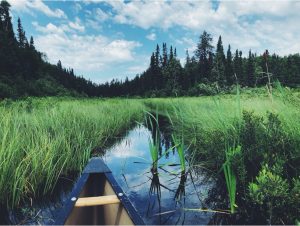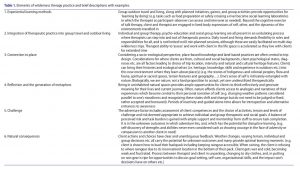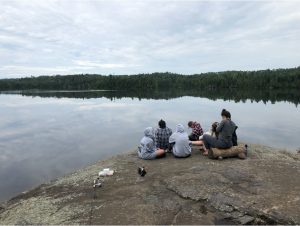35 An Insight into Wilderness Therapy
Hannah Dible

Hello! My name is Hannah Dible. I became interested in this idea through spending much of my time in high school and college outdoors. There are few places where I have been as captivated as I have when on a canoe in the middle of the Boundary Waters and this essay seeks to explain these feelings that many of you have most likely also felt before. Nature is captivating and healing and my chapter looks further into these thoughts…read more.

Nature has so many captivating qualities. Whether it be the rustle of summer green leaves, the indescribable blue of the sky on a clear day, or the countless creatures that scurry across the earth’s floor, I always find myself amazed by its peculiar yet familiar structure. Nature is something that is often taken for granted. Yes, individuals are constantly reminded of its presence, but do we often think of its value? For me, the wilderness has been a place of refuge and comfort. Somewhere that I look to when I am feeling lost and confused.
Recently, I had the pleasure of embarking on an eight-day canoeing trip in The Boundary Waters Canoe Area Wilderness in Minnesota with a group of my peers. Being surrounded by such beautiful and seemingly untouched land (as seen in Figure 1) was an unfamiliar yet incredible experience. While I have always immersed myself in nature for times of reflection, I had never experienced it on this extreme level. In the absence of technology and development, my mind had never felt so open and curious. Realizing how small of a speck I am in this vast, beautiful, and awe-inspiring world helped me gain perspective on my actions and eased many of my worries. During this time, I unconsciously found myself becoming more contemplative about my past, present, and future. I was able to wrestle with the feelings I had pushed to the back of my mind, such as a recent family illness, and I was able to clearly define what I wanted to do with my life: attend college and eventually work in an environmental field. During this trip I was challenged (both mentally and physically) in ways that I didn’t know were possible. After completing this experience, I was amazed at my newfound confidence and appreciation for the strength of both my body and mind. Boundary Waters was the place where I was truly enlightened about nature’s healing and meditative characteristics and after returning from this trip, I was curious if others felt the same way.

As I am constantly drawn towards nature, I ended up working as a camp counselor in the summer of 2019, which also led me to appreciate even more the peace that I am offered by wilderness. During this time, I met a now close friend who inspires me in so many different ways. One thing that I was extremely intrigued by was her former job. She worked in Oregon for approximately nine months as a part of a wilderness therapy program for adolescents struggling with substance use disorders. While wilderness therapy was a concept I was vaguely familiar with, I had never interacted with an individual who had first hand experience in this field. My inquisitive personality came alive and throughout the summer I often picked her brain about her experience. She talked about how rewarding this experience was that she was able to help these kids gain perspective and establish a positive relationship with the natural world. She expressed how these programs gave teens the opportunity to explore wilderness and bond with nature in a manner many had never experienced before. She also discussed how the program was life changing for many participants and they left feeling more relaxed and equipped to take on the real world. After hearing her experience with wilderness therapy, I knew that I had to find out more about how nature may serve as a healing tool.
What is wilderness therapy?
Wilderness therapy can manifest in many different forms, but for the sake of this conversation, I will be discussing formal wilderness therapy programs where individuals are a part of a group seeking some kind of relief from suffering (often mentally or with substance use disorders). Some of the key components of wilderness therapy outlined by Gabrielsen et al. (2019) include, wilderness, the physical self, and the psychosocial self. That is, being immersed in the natural world away from the distractions of every-day life, the body experiencing some sort of physical challenge, and challenging one’s thinking and mental constructions. One of the most basic definitions of wilderness therapy was outlined by Tucker, Norton, Demille, & Hobson in the article “The Impact of Wilderness Therapy: Utilizing an Integrated Care Approach” (2016). They explained that wilderness therapy includes “immersion in wilderness or comparable lands, groups living with peers, individual and group therapy sessions, and educational and therapeutic curricula, including backcountry travel and wilderness living skills.”
Another valuable insight that helped me contextualize wilderness therapy was a breakdown of the many elements that it entails which was outlined in the study conducted by Gabrielsen & Harper (2017), “The role of wilderness therapy for adolescents in the face of global trends of urbanization and technification.” These elements can be reviewed in Table 1 which clearly defines the expectations of each element.

Types of Wilderness Therapy Programs
As for the programs available for wilderness therapy, there are numerous options and offerings. While these programs are mainly focused towards adolescents and young adults due to the malleable nature of their brain and intense physical ability, there are programs for all age ranges available (Gabrielsen et al., 2019). The focus for these programs is generally for those who are struggling with their mental health or a substance use disorder (Tucker et al. 2016). These programs are licensed by a state agency and include a licensed mental health professional who oversees and evaluates the program’s success. Some well-known programs include Second Nature, Trails Carolina, and Red Oak Recovery which is specifically targeted to those struggling with substance use disorders. One of the drawbacks to wilderness therapy programs is the cost. Almost all programs are not typically covered by insurance so the accessibility of these programs to the general population is somewhat limited. Since these programs are not cheap, this kind of treatment option/experience is only available to those of a higher-class status who are willing to pay for wilderness therapy. Another peculiar limitation to this kind of therapy is the gender inequities that I found when evaluating numerous studies. I found that in many cases more males participated in this kind of therapy than females. This may be due to the perceived “ruggedness” of a wilderness therapy program coupled with traditional gender role stereotypes. However, the most common question surrounding wilderness therapy is: Are these programs actually effective?
Is wilderness therapy effective?
The simple answer to this question is generally, yes. Research on wilderness therapy outcomes provides both qualitative and quantitative results that suggest that this kind of therapy improves a participant’s quality of life. When participants reflect on these programs, they often cite them as a positive or life-altering experience. These claims are also supported by a myriad of evidence that has been collected.
A recent study that provided quantitative evidence of the effectiveness of wilderness therapy programs was conducted by Gabrielsen et al. (2019), “The effectiveness of wilderness therapy as mental health treatment for adolescents in Norway: a mixed methods evaluation”. This study included 32 adolescents (11 males and 21 females) with a mean age of 16.5 years. The experimental design for this study was a series of surveys such as the Sense of Coherence Scale and the General Perceived Self-Efficacy Scale which were given to participants pre-test, post-test, and as a follow up test (12 months after participation). The results of these tests were that all individuals showed improvement in nearly all of these tests with p values (from pre-test to follow up test) ranging from less than 0.1 to less than 0.01. When looking at a specific survey (Personal Life Circumstances), there were improvements in all categories the most notable being “I enjoy my spare time” and “I know myself well.” As well as the data collected from these surveys, researchers also found that one year following the program, 23 of the participants (71.8%) were no longer seeking mental health treatment.
Another study conducted by Matthew J. Hoag et al. (2013), “Efficacy of wilderness therapy for young adults: a first look ”, found similar results. This study consisted of 297 young adults (83 females and 224 males) with an average age of 20.2 years who completed at least five weeks of a wilderness therapy program. This study had a procedure similar to the previous study by having participants take five different surveys that are used to assess mental health at the time of intake and discharge. These surveys were then analyzed, and four out of the five surveys taken demonstrated a statistically significant improvement from the time of intake to the time of discharge. This led the researchers to conclude that these participants experienced a positive change in mental health as a result of the program.
There is also an abundance of qualitative data that has been collected from past participants in various wilderness therapy programs. Many participants cite gaining a sense of control after partaking in this program and believe that wilderness therapy gave them the structure and clarity they needed to get back in control of their own lives (Gabrielsen et al., 2019). It also helped many participants gain confidence in their abilities from the strenuous physical and mental challenges of the program, but also confidence in their interactions with others (Gabrielsen et al., 2019). Since nearly all of these programs are in a group environment, this setting helps individuals create genuine bonds and become great friends without the distractions of everyday life. Other participants found that the whole experience helped them realize the minuteness of their existence and allowed them to gain perspective on their situation (Greffrath et al., 2012). This point really resonates with me because as I mentioned before such perspective is always one of the things that grounds me when I am surrounded by the natural world. Lastly, another notable result of a wilderness therapy program that some participants experienced was a strengthened faith and/or a belief in God (Greffrath et al., 2012).
One large aspect of wilderness therapy that often seems to be somewhat glossed over is the spiritual aspect. A feeling that many cannot describe is the sense of connectedness they feel when immersed in the natural world. Some call it the force of God, some cite it as Mother Nature, and others define it as a general sense of spirituality, but regardless, nature has an unknown and peculiar aspect that leaves people in awe. This indescribable force and power of nature is something that cannot be formally studied or put under a microscope in a controlled sense. Many feel that it should be left to the imagination and interpretation of the individual.
Eugene H. Peterson attempts to describe how our actions and feelings of nature can relate to the spiritual or religious realm in a chapter of the book The Message of David – Earthly Spirituality for Everyday Christians. Peterson discusses how the mysteries and danger that nature brings along with its experience can be related to the mystery and power of God. Peterson also examines how wilderness is often a place where people are tested and tempted, which is present in many stories in the Bible. These parallels are drawn by many people, which can be seen in multiple reflections of an individual’s wilderness therapy program experience. Theological insights provide one of the many explanations as to why nature seems to unlock spiritual qualities inside an individual. These and other spiritual factors may be part of what makes wilderness experiences sublime.
After analyzing the quantitative and qualitative evidence provided by various studies, it is clear that wilderness therapy does have at least some positive impact on an individual. The sense of accomplishments and challenge leave an individual feeling better than when they first embarked on their journey. And there seem to be spiritual benefits to wilderness experience. But, why is wilderness therapy effective? To what extent does nature truly help individuals heal?
Why is wilderness therapy effective?
Researchers have developed numerous theories as to why participants find wilderness therapy to be so beneficial to their mental health. Many believe that the aspect of challenging the self both mentally and physically builds an enormous amount of confidence in individuals which is a clear factor in healing (Greffrath et al., 2012). Another reason for the effectiveness of these programs that researchers have cited is the presence of stability and structure (Gabrielsen, 2019). Many individuals find that the structure and stability of being in the natural world is soothing and calming. When in the wilderness, performing simple tasks makes your actions feel more vital to the group, which can enhance one’s sense of belonging. Being in the wilderness also helps individuals create authentic and genuine bonds with each other (Gabirelsen & Harper, 2017). Having a strong support system like this is essential in improving mental health. Lastly, researchers attribute the success of wilderness therapy programs to the lack of distractions that are present in everyday life such as cell phones and schoolwork (Tucker et al., 2016). In the real world it is all too easy to fall into the hustle and bustle of everyday life and researchers think that taking this large step back is essential in the success of these programs.
From my own personal experience, I find all of the reasons above to be very agreeable and discerned these ideas on my own journeys in wilderness. Nature truly seems to mend insecurities and foster intense bonds between individuals. Nature provides an individual with this unknown connection, that lets them explain it in their own way. I also strongly believe that nature helps individuals realize the value of life through the lens of the vast, beautiful world around us.
After analyzing many aspects of wilderness therapy, I am left with a few final inquiries. There are not many studies examining the lasting impact of these programs. While many studies conduct a follow-up interview one year after the conclusion of the program, I was not able to find longer term longitudinal data. I am curious to know if these programs leave a lasting impact on participants. Also, as I mentioned before, wilderness therapy proves to be a very cost intensive treatment option for an individual. I am interested to know if there are ways to make this treatment option more accessible to more individuals who are suffering and in need of assistance.

Wilderness therapy can also prove to be extremely exhaustive for the therapists and other field staff who pursue this line of work. Because of the intensive aspects of these programs, both mentally and physically, they can often lead to burn out of therapists and other leaders. A study conducted by Kolaski & Taylor in 2019 found that in the course of 2 years, the staff turnover will be 100% for these kinds of programs. My good friend who worked in wilderness therapy was only able to endure about nine months and she discussed how this was very common among her fellow employees. The intense style of these programs, the disconnect to family and friends as well as insufficient pay are some factors that may contribute to this type of instructor burnout (Kolaski & Taylor, 2019). This type of turnover can be extremely exhaustive for these programs and having to find new employees constantly can be a labor-intensive task that may stress program administration and take away from the quality of the overall experience.
In conclusion, wilderness therapy is a valuable tool that utilizes nature and its healing qualities to help struggling individuals. Whether it be gaining confidence, skills, clarity, or control, most participants find that wilderness therapy was an essential part of their healing process. While I believe nature will always possess many mysterious and powerful qualities, I think that its ability to heal and connect is one that has not failed many individuals who truly take time to interact with the natural world . Even though I personally was not seeking a therapy experience, I still have found that my personal experiences with nature allowed me to alleviate many stresses that were present in my life. For me and many others, the wilderness provides healing, balance, clarity, and something indescribable that leaves one craving the natural world and its mysterious qualities.
References
Gabrielsen, L. E., Eskedal, L. T., Mesel, T., Aasen, G. O., Hirte, M., Kerlefsen, R. E., Palucha, V., & Fernee, C. R. (2019). The effectiveness of wilderness therapy as mental health treatment for adolescents in Norway: A mixed methods evaluation. International Journal of Adolescence and Youth, 24(3), 282–296. https://doi.org/10.1080/02673843.2018.1528166
Gabrielsen, L. E., & Harper, N. J. (2017). The role of wilderness therapy for adolescents in the face of global trends of urbanization and technification. International Journal of Adolescence and Youth, 1–13. https://doi.org/10.1080/02673843.2017.1406379
Greffrath, G., Meyer, C. D. P., Strydom, H., & Ellis, S. (2012). The symbolic uniqueness of wilderness participation. African Journal for Physical, Health Education, Recreation & Dance, 18(1), 20–38.
Hoag, M. J., Massey, K. E., Roberts, S. D., & Logan, P. (2013). Efficacy of Wilderness Therapy for Young Adults: A First Look. Residential Treatment For Children & Youth, 30(4), 294–305. https://doi.org/10.1080/0886571X.2013.852452
Kolaski, A. Z., & Taylor, J. M. (2019). Critical Factors for Field Staff: The Relationship Between Burnout, Coping, and Vocational Purpose. Journal of Experiential Education, 42(4), 398–416. https://doi.org/10.1177/1053825919868817
Peterson, E. H. (1997). The Message of David – Earthy Spirituality for Everyday Christians. Marshall Pickering. 71-80.
Tucker, A., Norton, C. L., DeMille, S. M., & Hobson, J. (2016). The Impact of Wilderness Therapy. Journal of Experiential Education, 39(1), 15–30. https://doi.org/10.1177/1053825915607536
